Skip
To Content
 |
| October 18, 2007 |
A Day in the Life of American Adolescents: Substance Use Facts
In Brief
- This issue of The OAS Report presents facts about adolescent substance use, including information on the initiation of substance use, past year substance use, and receipt of substance use treatment. The data presented in this report are from the 2006 National Survey on Drug Use and Health (NSDUH), the 2005 Treatment Episode Data Set (TEDS), and the 2005 National Survey of Substance Abuse Treatment Services (N-SSATS).
|
In the United States in 2006, one third of adolescents aged 12 to 17 drank alcohol in the past year, one fifth used an illicit drug, and one sixth smoked cigarettes.1 Although the percentage of adolescents using alcohol and drugs declined between 2002 and 2006, the percentage of persons aged 12 to 17 receiving substance abuse treatment has remained relatively stable.2,3 In 2005, 7.7 percent of all persons admitted to publicly funded treatment facilities were aged 12 to 17.4
The Office of Applied Studies (OAS) in the Substance Abuse and Mental Health Services Administration (SAMHSA) collects, analyzes, and disseminates critical public health data. OAS manages three national data collections that offer insight into adolescent substance use and treatment: the National Survey on Drug Use and Health (NSDUH), the Treatment Episode Data Set (TEDS), and the National Survey of Substance Abuse Treatment Services (N-SSATS).5-8
This issue of The OAS Report presents facts about adolescent substance use, including initiation, and receipt of treatment for substance use "on an average day."9 Data presented in this report from the 2006 NSDUH and the 2005 TEDS are for adolescents aged 12 to 17; data presented from the 2005 N-SSATS are for youth under 18.
First Substance Use
According to the 2006 NSDUH, 10.6 percent of adolescents aged 12 to 17 drank alcohol for the first time in the past year, and 5.8 percent used an illicit drug10 for the first time. The 2006 NSDUH also indicates that on an average day during the past year, adolescents aged 12 to 17 used the following substances for the first time (Figure 1):
- 7,970 drank alcohol for the first time;
- 4,348 used an illicit drug for the first time;
- 4,082 smoked cigarettes for the first time;
- 3,577 used marijuana for the first time;
- 2,517 used pain relievers nonmedically for the first time;
- 1,603 used inhalants for the first time;
- 1,281 used hallucinogens for the first time;
- 909 used cocaine for the first time;
- 860 used stimulants nonmedically for the first time;
- 236 used methamphetamine for the first time; and
- 86 used heroin for the first time.
Figure 1. Number of Adolescents Aged 12 to 17 Who Used Cigarettes, Alcohol, or Illicit Drugs for the First Time on an Average Day: 2006 NSDUH
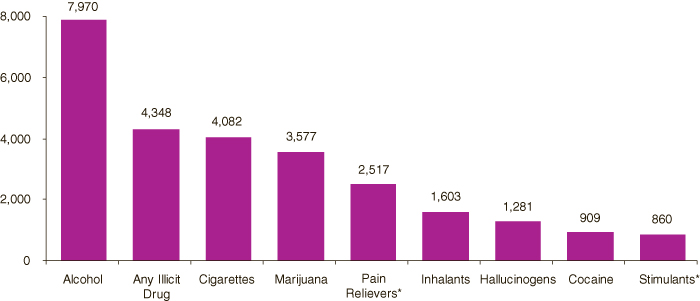 |
Figure 1 Table. Number of Adolescents Aged 12 to 17 Who Used Cigarettes, Alcohol, or Illicit Drugs for the First Time on an Average Day: 2006 NSDUH
| Substance |
Number of Adolescents |
| Alcohol |
7,970 |
| Any Illicit Drug |
4,348 |
| Cigarettes |
4,082 |
| Marijuana |
3,577 |
| Pain Relievers* |
2,517 |
| Inhalants |
1,603 |
| Hallucinogens |
1,281 |
| Cocaine |
909 |
| Stimulants* |
860 |
| Source: SAMHSA, 2006 NSDUH. |
Cigarette, Alcohol, and Illicit Drug Use
According to the 2006 NSDUH, more than 8 million adolescents aged 12 to 17 drank alcohol in the past year, nearly 5 million used an illicit drug, and more than 4 million smoked cigarettes. In addition, on an average day during the past year, adolescents aged 12 to 17 used the following substances (Figure 2):
- 1,245,240 smoked cigarettes;
- 630,539 drank alcohol;
- 586,454 used marijuana;
- 49,263 used inhalants;
- 26,645 used hallucinogens;
- 13,125 used cocaine; and
- 3,753 used heroin.
Figure 2. Number of Adolescents Aged 12 to 17 Who Used Cigarettes, Alcohol, or Illicit Drugs on an Average Day: 2006 NSDUH
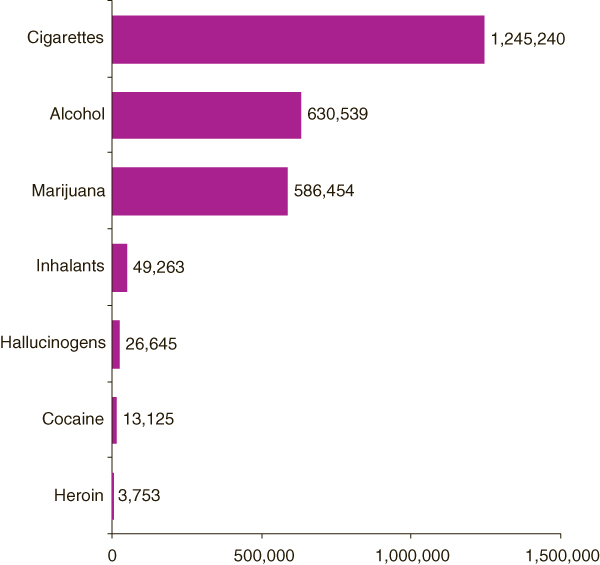 |
Figure 2 Table. Number of Adolescents Aged 12 to 17 Who Used Cigarettes, Alcohol, or Illicit Drugs on an Average Day: 2006 NSDUH
| Substance |
Number of Adolescents |
| Cigarettes |
1,245,240 |
| Alcohol |
630,539 |
| Marijuana |
586,454 |
| Inhalants |
49,263 |
| Hallucinogens |
26,645 |
| Cocaine |
13,125 |
| Heroin |
3,753 |
| Source: SAMHSA, 2006 NSDUH. |
The 2006 NSDUH also indicates that:
- adolescents who used alcohol in the past month drank an average of 4.7 drinks per day on the days they drank; and
- adolescents who smoked cigarettes in the past month smoked an average of 4.6 cigarettes per day on the days they smoked.
Substance Abuse Treatment
TEDS reported that in 2005 there were 142,646 admissions for adolescents aged 12 to 17 to substance abuse treatment programs (TEDS data come primarily from facilities that receive some public funding). TEDS also indicates that on an average day in 2005, adolescent admissions to treatment presented with the following substances as the primary substance of abuse11 (Figure 3):
- 255 with marijuana;
- 72 with alcohol;
- 24 with stimulants;
- 10 with cocaine;
- 7 with opiates; and
- 7 with other drugs.
Figure 3. Number of Adolescents Aged 12 to 17 Admitted to Publicly Funded Substance Abuse Treatment Facilities on an Average Day, by Primary Substance of Abuse: 2005 TEDS
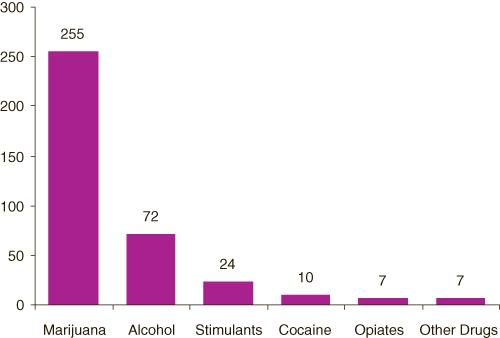 |
Figure 3 Table. Number of Adolescents Aged 12 to 17 Admitted to Publicly Funded Substance Abuse Treatment Facilities on an Average Day, by Primary Substance of Abuse: 2005 TEDS
| Substance |
Number of Adolescents |
| Marijuana |
255 |
| Alcohol |
72 |
| Stimulants |
24 |
| Cocaine |
10 |
| Opiates |
7 |
| Other Drugs |
7 |
| Source: SAMHSA, 2005 TEDS. |
The 2005 TEDS also indicates that on an average day in 2005, the number of adolescent admissions to substance abuse treatment were referred by the following sources12 (Figure 4):
- 189 by the criminal justice system;
- 66 by self-referral or referral from other individuals;
- 43 by schools;
- 37 by community organizations;
- 22 by alcohol or drug treatment providers; and
- 18 by other health care providers.
Figure 4. Number of Substance Abuse Treatment Admissions among Adolescents Aged 12 to 17 on an Average Day, by Principal Source of Referral: 2005 TEDS
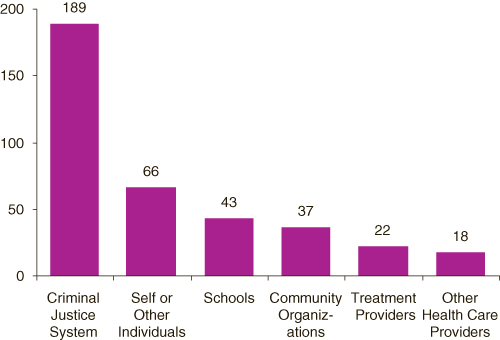 |
Figure 4 Table. Number of Substance Abuse Treatment Admissions among Adolescents Aged 12 to 17 on an Average Day, by Principal Source of Referral: 2005 TEDS
| Source of Referral |
Number of Admissions |
| Criminal Justice System |
189 |
| Self or Other Individuals |
66 |
| Schools |
43 |
| Community Organizations |
37 |
| Treatment Providers |
22 |
| Other Health Care Providers |
18 |
| Source: SAMHSA, 2005 TEDS. |
In addition, N-SSATS, which collects information on substance abuse treatment at both publicly and privately funded facilities, reports how many active clients13 under the age of 18 received the following types of substance abuse treatment on an average day in 2005 (Figure 5):
- 76,240 were clients in outpatient treatment;
- 10,313 were clients in non-hospital residential treatment; and
- 1,058 were clients in hospital inpatient treatment.
Figure 5. Number of Adolescents Under Age 18 Who Were Clients in Publicly or Privately Funded Substance Abuse Treatment Facilities on an Average Day, by Service Type: 2005 N-SSATS
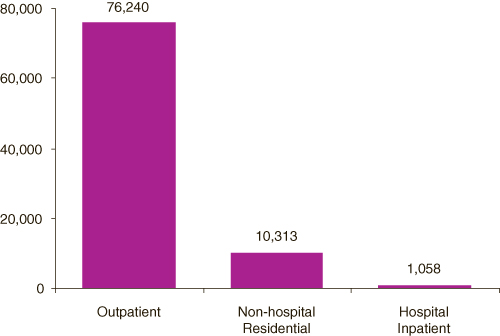 |
Figure 5 Table. Number of Adolescents Under Age 18 Who Were Clients in Publicly or Privately Funded Substance Abuse Treatment Facilities on an Average Day, by Service Type: 2005 N-SSATS
| Service Type |
Number of Adolescents |
| Outpatient |
76,240 |
| Non-hospital Residential |
10,313 |
| Hospital Inpatient |
1,058 |
| Source: SAMHSA, 2005 N-SSATS. |
End Notes
1 Office of Applied Studies. (2007). Results from the 2006 National Survey on Drug Use and Health: National findings (DHHS Publication No. SMA 07-4293, NSDUH Series H-32). Rockville, MD: Substance Abuse and Mental Health Services Administration.
2 Office of Applied Studies. (2003, September; updated 2005, June). Results from the 2002 National Survey on Drug Use and Health: Detailed tables. Rockville, MD: Substance Abuse and Mental Health Services Administration. [Available at http://www.oas.samhsa.gov/WebOnly.htm#NSDUHtabs]
3 Office of Applied Studies. (2007, September). Results from the 2006 National Survey on Drug Use and Health: Detailed tables. Rockville, MD: Substance Abuse and Mental Health Services Administration. [Available at http://www.oas.samhsa.gov/WebOnly.htm#NSDUHtabs]
4 Office of Applied Studies, Substance Abuse and Mental Health Services Administration. Treatment Episode Data Set (TEDS), 2005 [Data file]. Data received through 10.3.06.
5 NSDUH is the Nation's primary source of information on the prevalence of illicit drug use among the civilian, noninstitutionalized population aged 12 or older, and it also provides estimates of alcohol and tobacco use and mental health problems. Begun in 1971 and conducted annually since 1990, NSDUH is sponsored by SAMHSA and collects data from a representative sample of the population aged 12 or older. NSDUH data are collected through face-to-face computer-assisted interviews at the respondent's place of residence. Items on sensitive topics such as drug use are self-administered to ensure privacy and promote accurate reporting.
6 TEDS is an annual compilation of data on the demographic characteristics and substance abuse problems of those admitted to substance abuse treatment, primarily at facilities that receive some public funding. TEDS records represent admissions rather than individuals because a person may be admitted to substance abuse treatment more than once during a single year. In 2005, TEDS collected data on 1.8 million admissions to substance abuse treatment facilities. Four States and jurisdictions (AK, DC, NM, and WY) did not submit data for 2005. The 2005 TEDS information presented in this issue is based on data received through October 3, 2006.
7 N-SSATS is an annual survey of all known facilities in the United States, both public and private, that provide substance abuse treatment. N-SSATS is a point-prevalence survey with a reference date of the last weekday in March (e.g., March 31, 2005). For this report, "on an average day" refers to that point-prevalence date. The 2005 N-SSATS has information on facilities that offer specially designed treatment programs or groups for specific types of clients, including adolescents. This report presents data based on the responses of 4,709 facilities that reported treating clients younger than 18 years old.
8 Office of Applied Studies, Substance Abuse and Mental Health Services Administration. National Survey of Substance Abuse Treatment Services (N-SSATS), 2005 [Data file].
9 For NSDUH, the number of adolescents who used alcohol, cigarettes, or illicit drugs "on an average day" is calculated by summing the weighted past month frequency of use (0 to 30 days) for each respective substance and dividing by 30. The number of adolescents who use alcohol, cigarettes, or illicit drugs for the first time in the past year "on an average day" is calculated by summing the weighted counts of respondents who both initiated substance use in the past year and were between the ages of 12 and 17, and dividing by 365. The average number of cigarettes smoked or alcoholic drinks consumed per day in the past month among past month users is calculated using a weighted average or mean of the number of cigarettes or drinks reported by past month users. For TEDS, admission totals "on an average day" were calculated by dividing the annual admission total by 365. For N-SSATS, "on an average day" refers to the point-prevalence date of March 31, 2005.
10 Illicit drugs are defined as marijuana/hashish, cocaine (including crack), inhalants, hallucinogens, heroin, or prescription-type drugs used nonmedically. Nonmedical use is defined as the use of prescription-type drugs not prescribed for the respondent by a physician or used only for the experience or feeling they caused. Nonmedical use of any prescription-type pain reliever, sedative, stimulant, or tranquilizer does not include over-the-counter drugs. Nonmedical use of stimulants includes methamphetamine use.
11 The primary substance of abuse is the main substance reported at the time of admission.
12 The principal source of referral is the person or agency referring the client to the alcohol or drug abuse treatment program.
13 The number of active clients in treatment in the 2005 N-SSATS was defined as (1) hospital inpatient and non-hospital residential clients receiving substance abuse treatment services at the facility on March 31, 2005, and (2) outpatient clients who were seen at the facility for a substance abuse treatment or detoxification service at least once during the month of March 2005 and who were still enrolled in treatment as of March 31, 2005.
Figure Note
* Nonmedical use; see End Note 10.
Suggested Citation
Substance Abuse and Mental Health Services Administration, Office of Applied Studies. (October 18, 2007). The OAS Report: A Day in the Life of American Adolescents: Substance Use Facts. Rockville, MD.
The National Survey on Drug Use and Health (NSDUH), the Treatment Episode Data Set (TEDS), and the National Survey of Substance Abuse Treatment Services (N-SSATS) are three major data collections conducted by the Substance Abuse and Mental Health Services Administration's Office of Applied Studies (SAMHSA/OAS).
NSDUH is an annual survey that collects data by administering questionnaires to a representative sample of the population through face-to-face interviews at their place of residence. The 2006 past year use data for this report are based on information obtained from 22,871 persons aged 12 to 17. Data related to past year substance initiation between the ages of 12 and 17 are based on information obtained from 25,926 persons aged 12 to 18.
TEDS data are collected through State administrative systems and are then submitted to SAMHSA. They include information on admissions to substance abuse treatment primarily from facilities that receive some public funding. The 2005 TEDS data presented in this report are based on data received through October 3, 2006, and include data from 142,646 admissions aged 12 to 17.
N-SSATS is an annual census of all known substance abuse treatment facilities in the United States. On the survey reference date of March 31, 2005, there were 87,611 clients younger than age 18 in 4,709 facilities. Facilities responded to the survey via mail, Internet, or telephone.
For more information, see the following publications:
Office of Applied Studies. (2007). Results from the 2006 National Survey on Drug Use and Health: National Findings (DHHS Publication No. SMA 07-4293, NSDUH Series H-32). Rockville, MD: Substance Abuse and Mental Health Services Administration.
Office of Applied Studies. (2007). Treatment Episode Data Set (TEDS): 1995-2005. National Admissions to Substance Abuse Treatment Services (DHHS Publication No. SMA 07-4234, DASIS Series: S-37). Rockville, MD: Substance Abuse and Mental Health Services Administration.
Office of Applied Studies. (2006). National Survey of Substance Abuse Treatment Services (N-SSATS): 2005. Data on Substance Abuse Treatment Facilities (DHHS Publication No. SMA 06-4206, DASIS Series: S-34). Rockville, MD: Substance Abuse and Mental Health Services Administration.
The OAS Report is prepared by the Office of Applied Studies (OAS), SAMHSA, and by RTI International in Research Triangle Park, North Carolina. (RTI International is a trade name of Research Triangle Institute.) |
| The OAS Report is published periodically by the Office of Applied Studies, Substance Abuse and Mental Health Services Administration (SAMHSA). All material appearing in this report is in the public domain and may be reproduced or copied without permission from SAMHSA. Additional copies of this report or other reports from the Office of Applied Studies are available online: http://www.oas.samhsa.gov. Citation of the source is appreciated. For questions about this report, please e-mail: shortreports@samhsa.hhs.gov. |
|

This page was last updated on July 11, 2008.
|






